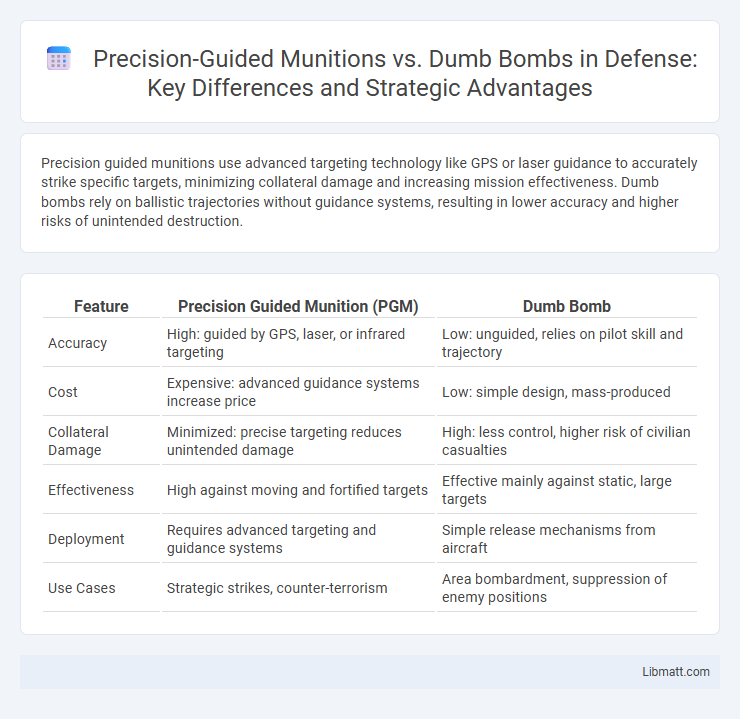Precision guided munitions use advanced targeting technology like GPS or laser guidance to accurately strike specific targets, minimizing collateral damage and increasing mission effectiveness. Dumb bombs rely on ballistic trajectories without guidance systems, resulting in lower accuracy and higher risks of unintended destruction.
Table of Comparison
| Feature | Precision Guided Munition (PGM) | Dumb Bomb |
|---|---|---|
| Accuracy | High: guided by GPS, laser, or infrared targeting | Low: unguided, relies on pilot skill and trajectory |
| Cost | Expensive: advanced guidance systems increase price | Low: simple design, mass-produced |
| Collateral Damage | Minimized: precise targeting reduces unintended damage | High: less control, higher risk of civilian casualties |
| Effectiveness | High against moving and fortified targets | Effective mainly against static, large targets |
| Deployment | Requires advanced targeting and guidance systems | Simple release mechanisms from aircraft |
| Use Cases | Strategic strikes, counter-terrorism | Area bombardment, suppression of enemy positions |
Introduction to Precision Guided Munitions and Dumb Bombs
Precision guided munitions (PGMs) utilize advanced targeting systems such as GPS, laser guidance, and infrared sensors to accurately strike specific targets, significantly reducing collateral damage compared to dumb bombs, which are unguided and rely solely on ballistic trajectory. PGMs increase mission effectiveness by improving hit probability and minimizing ammunition expenditure, whereas dumb bombs generally require larger quantities and result in higher risks of unintended destruction. This technological advancement in guided weaponry marks a pivotal shift in modern warfare by enhancing precision and operational efficiency.
Historical Evolution of Aerial Bombing Technology
Precision guided munitions (PGMs) revolutionized aerial bombing technology by introducing advanced targeting accuracy through GPS, laser guidance, and infrared sensors, significantly reducing collateral damage compared to traditional dumb bombs. Historically, aerial bombing began with unguided dumb bombs in World War I and evolved through World War II's mass bombardments, which lacked precision and often caused widespread destruction. Your understanding of modern aerial warfare highlights the shift from indiscriminate bombing to surgically precise strikes that enhance mission effectiveness and minimize civilian casualties.
Mechanisms of Guidance: How Precision Guided Munitions Work
Precision guided munitions (PGMs) utilize advanced guidance mechanisms such as GPS, laser, infrared, or radar seekers to accurately track and strike targets with minimal collateral damage. These guidance systems continuously adjust the munition's flight path in real-time, ensuring high accuracy even in dynamic combat environments. In contrast, dumb bombs follow a ballistic trajectory determined by initial release parameters without in-flight correction, resulting in lower precision and higher risk of unintended damage.
Cost Comparison: Precision Guided Munitions vs. Dumb Bombs
Precision guided munitions (PGMs) generally have higher upfront costs, often ranging from $20,000 to over $100,000 per unit, compared to dumb bombs, which can cost as little as a few hundred to a few thousand dollars each. Despite this price gap, PGMs reduce collateral damage and improve mission effectiveness, potentially lowering overall operational expenses by minimizing the need for repeat strikes and limiting unintended damage. Your strategic investment in PGMs can lead to cost savings over time due to their enhanced accuracy and reduced logistical burdens compared to traditional unguided bombs.
Accuracy and Targeting Capabilities
Precision guided munitions (PGMs) use advanced guidance systems such as GPS, laser, or infrared homing, enabling them to strike within a few meters of a designated target with high accuracy. Dumb bombs rely solely on ballistic trajectories, resulting in significantly lower precision and higher collateral damage. The superior targeting capabilities of PGMs reduce unintended casualties and increase mission effectiveness.
Operational Effectiveness in Combat Scenarios
Precision guided munitions (PGMs) significantly enhance operational effectiveness by delivering accurate strikes on high-value targets, minimizing collateral damage and reducing the number of sorties required. Dumb bombs lack targeting systems, often necessitating multiple bombs and passes to achieve mission success, increasing risk to aircraft and personnel. The accuracy of PGMs leads to higher mission success rates and improved resource efficiency in complex combat scenarios.
Minimizing Collateral Damage and Civilian Risk
Precision guided munitions utilize advanced targeting systems such as GPS, laser guidance, and infrared sensors to accurately strike specific targets, significantly reducing collateral damage and civilian casualties compared to traditional dumb bombs. Dumb bombs, lacking guidance technology, often result in wider blast radii and unpredictable impact zones, increasing the risk to non-combatants and surrounding infrastructure. Military operations incorporating precision guided munitions demonstrate enhanced effectiveness in minimizing unintended harm while achieving mission objectives.
Impact on Military Strategy and Battlefield Tactics
Precision guided munitions (PGMs) revolutionize military strategy by enabling targeted strikes that minimize collateral damage, allowing forces to engage high-value targets with greater accuracy and efficiency compared to dumb bombs. Battlefield tactics shift towards precision engagements, reducing the need for widespread area bombardment and enabling smaller, more flexible force deployments. Your operational planning benefits from enhanced situational awareness and resource allocation, ultimately increasing mission success rates and reducing unintended consequences.
Limitations and Challenges of Each Weapon Type
Precision guided munitions face limitations such as high costs, reliance on advanced targeting systems, and vulnerability to electronic countermeasures, which can affect accuracy and effectiveness in complex combat environments. Dumb bombs, while cost-effective and simple to deploy, suffer from limited accuracy, increasing collateral damage and requiring multiple sorties to achieve target destruction. Both weapon types confront challenges related to environmental conditions, operational constraints, and evolving enemy defenses that impact mission success rates.
Future Trends in Bombing Technology
Future trends in bombing technology emphasize the expansion of precision-guided munitions (PGMs) due to their increased accuracy, reduced collateral damage, and enhanced target discrimination. Advances in sensor fusion, artificial intelligence, and GPS guidance systems are pushing PGMs towards greater autonomy and adaptability in dynamic combat environments compared to traditional unguided bombs. Continuous innovation in lightweight materials and miniaturization further enables precision munitions to penetrate advanced defenses and support asymmetrical warfare strategies effectively.
precision guided munition vs dumb bomb Infographic

 libmatt.com
libmatt.com